A SUPERBOLIDE CROSSING OVER PENINSULAR IBERIA IN BROAD DAYLIGHT, BEING FILMED FROM SEVERAL POINTS IN SPAIN.
AN IMPRESSIVE DAYLIGHT FIREBALL STUNS THOUSANDS OF PEOPLE PRODUCING A METEORITE SHOWER.
An impressive fireball much brighter than the Full Moon was observed around 16h46m45s (+-10s) UTC on Sunday 4 January, 2004.
In spite of appearing in broad daylight it was seen by thousands of people, who were attending diverse festivities in the Northern part
of the peninsula. Some of them were able to obtain a record of great scientific value, filming the bolide over well known landmarks in
Leon, for example. This press release tries to clarify the nature of this phenomenon, which was produced by the entering of a fragment
of a comet or asteroid in the terrestrial atmosphere. When encountering the Earth at speeds of order of tens of thousand of kilometers/hour,
these fragments produce a bright light phenomena called a fireball or bolide. The object of January 4 underwent strong fragmentation
along its route. We believe that remains might have survived, since when the fireball was filmed at the end of its trajectory, over the
edge between Leon and Burgos, it already was below 30 kilometres altitude. We continue to investigate the data on the trajectory to
determine the locations of a possible meteorite fall. In the coming days we will incorporate on this page all the new data that are
coming forth based on the images and information offered by the lucky witnesses of this historical event.
 DISCOVERED NEW SAMPLES THANKS TO THE CALCULATION OF THE DISTRIBUTION ELLIPSE
FROM THE TRAJECTORY DATA.
DISCOVERED NEW SAMPLES THANKS TO THE CALCULATION OF THE DISTRIBUTION ELLIPSE
FROM THE TRAJECTORY DATA.
A group search integrated by members and collaborator of this Network of Investigation on Bolides and Meteorites
in narrow collaboration with the created one by the National Museum of Natural Sciences of Madrid (MNCN)
has discovered the last weeks new samples of the meteorite that the past 4 of January fragmented on the Palencia mountains.
The discovered pieces come to add themselves to which has recently been announced by Dr. Javier Garcia Guinea (MNCN) which these days in the
display organised by the National Museum to enjoy everybody. The investigations are being developed in a very concrete zone of the North of Palencia
in basis to the defined data obtained by the first time in Spain thanks to the reconstruction of the trajectory and the determination of the
speed of the object and the height to which it fragmented thanks to the work of the members and collaborator of this Network.
The recovery area will continue staying in secret to obtain the meteorite's recovery by expert hands with the main
idea to be a legacy for our descendants. It must be avoided that they finish into the hands of unscrupulous salesmen
since it has happened in other occasions in different parts from the World. The search workings estan being led
by Jose Vte.Casado, Francisco Galindo and Stanislaus J. Erbrink of the Palencia Astronomical Society,
Ricardo Chao, Jesús San José and Saul Blanco of the Leon Astronomical Society. The team leadered
by Dr. Javier Garcia Guinea
(MNCN) is integrated by Martín Fernández Hernán, Tomas Lombardero, José Maria Calvo and Virgilio Correcher. All of them being
coordinated by the team of professionals integrated in our Network who are seeing fascinated as the number of recovered samples
increase day after day.
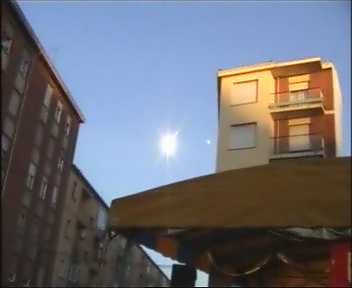
Image obtained from Leon when the 'Twelfth Night parade' was filmed. A star of Betlehem specially improvised for the occasion.
The intense brilliance of the bolide while it disintegrated can be appreciated. Image of Luis
Alfonso Fernandez Arenas and Carmen Blanco, courtesy of TVE.
TV1.
CALCULATION OF THE PRELIMINARY TRAJECTORY.
For the very first time, it has been possible to accurately reconstruct the trajectory of a bolide appearing in broad daylight in Spain, thanks to the tenacity
of a team of young investigators within the Network of Investigation on Bolides and Meteorites. Usually they only register bolides appearing at night.
The reconstruction of the preliminary trajectory has been made by Dr Josep Maria Trigo-Rodriguez of the Institute of Geophysics & Planetary Physics
of the Univ. California Los Angeles, Dr Jose Luis Ortiz of the Instituto de Astrofisica de Andalucia, Dr Jordi Llorca Pique of the University of Barcelona
and the "Institut d'Estudis Espacials de Catalunya" (IEEC), and Dr Jose Angel Docobo (Astronomical observatory Ramon Maria Aller-University of Santiago
de Compostela). The bolide presumably was caused by the disintegration of a fragment of an asteroid when it hit the terrestrial atmosphere at a speed
of approximately of 19±3 km/s. Based on the brightness of the object, which almost equaled that of the Sun, these investigators suggest that the initial mass of the meteoroid
could have been equal or superior to ten metric tons, although this data will need to be further modeled after the precise trajectory data as the investigations
continue.
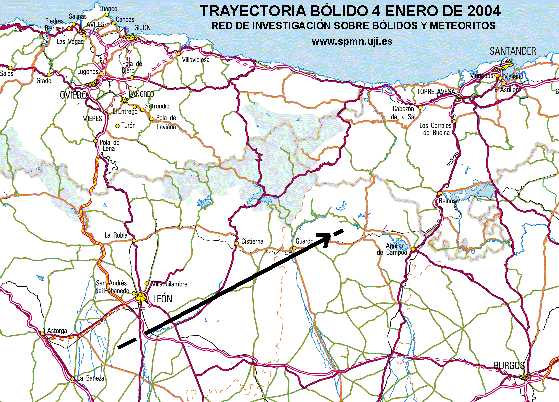
The preliminary trajectory as obtained by the Spanish Network of Investigation on Bolides and Meteorites team.
For publication the image must be given the source. Click on the image for a large resolution version.
In opinion of the research team the fact that this was a bolide observed in broad daylight has added a great degree of difficulty to their investigation, but
with the magnificent video registristration and photographs available they have been able to reconstruct the trajectory and, after precise study, it will even
be possible to determine the orbit in the Solar System of the parent body of this bolide. Although during the last week diverse sources have speculated
on the type of trajectory, now our team is able to present the press preliminary results based on the measurements made on the images taken of the bolide
from the capitol city of Leon, Hoces and Villalbeto de la Sierra (Palencia) cordially made available to the Network of Investigation on Bolides and
Meteorites by its authors. The deduced trajectory shows the bolide starting over the south of the province of Leon, it flew
over the city of Leon when it was at about 80 kilometers altitude going towards Guardo and exploding at 30 kilometers altitude shortly after, over the
North of the province of Palencia. The fragments continued descending, still generating light below 20 kilometers altitude. This appears highly favourable
for the hypothesis of survival of pieces. In addition, after prolonging the trajectory in the sky backwards, we could pinpoint the area in the sky from
which it came (called the radiant), which provides us data on the origin of the object that produced it. What we know at the moment is that the apparent
radiant area allows us to discard completely that the fireball could be associated to the meteor shower of the Quadrantids, as some other sources have
been suggesting without base. Nevertheless, it is very possible that the origin of the body is in the asteroid belt: in fact, we are studying whether this
bolide could be associated to other one which appeared on 3 January of 1970, and produced a meteorite that was recovered in Lost City, Oklahoma
(USA) after its trajectory had been registered by means of a network of automated cameras. This is fascinating, as earlier on 6 April 2002 the
European Fireball Network registered a bolide over Bavaria that could be related to the historical Pribam meteorite, fallen in the Czech village of the same name
on 7 April 1959. Nevertheless the investigators remain cautious on the radiant area since they need to make precise calibrations during the next weeks
to confirm this possible relationship.
 THE METEORITE ARE ORDINARY CHONDRITES.
THE METEORITE ARE ORDINARY CHONDRITES.
Dr. Javier Garcia Guinea of the "Museo Nacional de Ciencias
Naturales" of Madrid and of the "Centro Superior de Investigaciones Cientificas (CSIC)" made the first test to the two
first samples of 22 and 42 grams recovered by Abel Tarilonte in the anticipated zone of fall in the North of Palencia.
This previous analysis was POSITIVE indicating correctly that it was a meteorite.
At this moment our colleague Dr. Jordi Llorca (UB-IEEC) of the Spanish Fireball and Meteorite
Recovery Network works on one of these pieces affirming that "they clearly belong to the group of ordinary condrites although the determination of its
petrologic type will need some time". In consequence, we are before an historical meteorite recovery in our country. The meteorites show a clear fusion crust and an intact interior that
seems to confirm its rocky character.
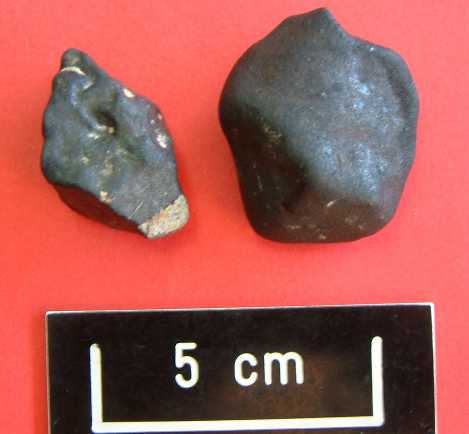
First images of the two first recovered meteorites obtained by Dr. Javier Garcia Guinea (Museo Nacional
Ciencias Naturales-CSIC).
BOLIDES: SEPARATING BETWEEN The MYTH And The FACTS.
The fact that we are investigating this occurrence is for a well defined reason, which is focussing on the scientificly interesting question
about the exact nature of the object which produced the luminous phenomena. An event of this type is so spectacular in nature that it typically
goes associated with quite common misinterpretations about the nature of these fireball events, which leads to a certain degree of subjectivity
in the reports. An example of the latter to emphasize, are the reported fires that are thought to have been associated with this phenomenon:
they were reported in several localities along the Mediterranean coast and the peninsular interior. The witnesses came to these conclusions
from the final part of visibility of the bolide, during which she fragmented into several pieces travelling close together. When this was
observed happening close to the horizon, they contributed to a visual effect simulating the origin of a local spreading forest fire.
Some pieces were coming off under oblique angles to the travelling route of the bolide, one reason why this impression of apparent
'ignition' is not so surprising. However, it is certain that the fragments (if really they survived) were hundreds of kilometers away
from the mediterranean coast or the peninsular center. In fact, meteorite fragments never arrive in a warm state to ground level,
since the fragmentation process takes place tens of kilometers above the terrestrial surface. Very few meteoroids usually survive
below the stratopause since in those regions the increasing density of the atmosphere puts them under enormous stress that are the
main cause of the resulting fragmentation. Whether they pulverize or survive depends on the density and consistency of the material
from which they are made, and their angle of entrance in the atmosphere. Once decelerated, the fragments cease being incandescent
and go into free fall crossing the stratosphere and they are cooling progressively until arriving at the ground. That part of their fall
is completely invisible for us from the ground since melting and evaporation ('ablation') of the outer surface does not longer take
place: this phase of the fall is called dark flight. When, after several minutes of free fall,
a remnant particle arrives at the ground, it is completely cold, having a dark outer crust of a milimetre or less thickness called the
fusion crust. If the dimension of the remaining particle is large enough, the interior of the
meteorite usually remains pristine and its scientific interest is extraordinary.
Large scientific value is attached to the fact that several localities in Leon and Palencia were witness to a
powerful explosion and felt a strong pressure wave likely produced at high altitude (20 to 30 kms): at these altitudes the meteoroid,
incapable to resist the growing atmospheric pressure when descending, fragmented in multiple pieces. The shock wave is not an
earthquake resulting from a ground impact, but a tremor produced when the pressure wave produced higher up in the atmosphere
arrived at ground level. It is similar to an airplane breaking the sound barrier and producing a strong sonic boom that makes buildings
and windows tremor. All information contributed on this topic will be enormously valuable to us, so if you saw the fireball or heard
the expolosions, we request to let us know by e-mail.
 THE PERSISTENT WAKE: A HISTORIC DOCUMENT. THE PERSISTENT WAKE: A HISTORIC DOCUMENT.
Besides demonstrating the meteoritic origin of the bolide of 4 January, the gathered data on speed,
sound phenomena, the penetration of the material in the atmosphere and the persistent wake are clear
evidence that we face one of the most important events of the past decades in this field in Spain. It is a
fascinating thought that this no doubt will become the best documented case in our country ever. The
documentation of the persistent wake and its evolution in the upper atmosphere is really unique and rarely
seen in the history of research on great bolide apparitions. Through Jesus Martin we obtained a really
impressive series of photographs from Villalbeto de la Peña (Palencia) showing how the wake of the
bolide evolved in the atmosphere. From these we will be able to determine the wind profile for those
moments in the Mesosphere and the Stratosphere. In addition, since the image was obtained only three
minutes after apparition of the bolide, it is of great value in order to determine the correct trajectory
of the fireball through the atmosphere.
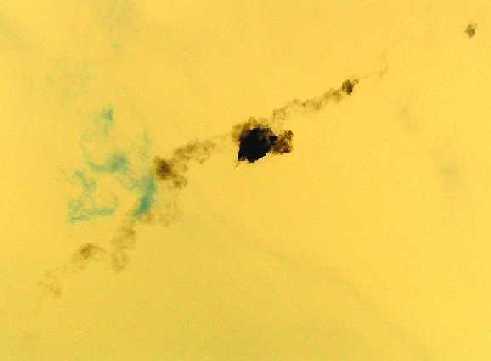
Impressive image obtained by Jesus Martín from Villalbeto de la Peña (Palencia).
Image processing and enhancement by Dr. Josep M. Trigo (UCLA). Several explosions throughout the
trajectory of the fireball. Notice the presence of low clouds (greenish)
which distinguishes clearly after suitable treatment of the image. In case of publication, the author
and the Spanish Fireball and Meteorite Recovery Network (SPMN)
must be referred as the source.
IT WAS NOT THE RE-ENTRY OF AN ARTIFICIAL SATELLITE.
One of the first steps taken by Spanish Fireball and Meteorite
Recovery Network was to discard the option that this luminous phenomenon was associated with the re-entry
of an artificial satellite. Dr William Ailor, director of Center for Orbital and Reentry Debris Studies (CORDS) of The Aerospace
Corporation has informed us that no re-entry
was predicted to happen over Spain on this date. This information and the high speed the bolide has on the video image make
us conclude that it is instead a fragment of an asteroid or comet entering the terrestrial atmosphere at great speed. With the astrometric
study of images obtained we will be able to determine the trajectory along which it traveled in the atmosphere, its speed and, possibly,
the orbit in which it revolved around the Sun.
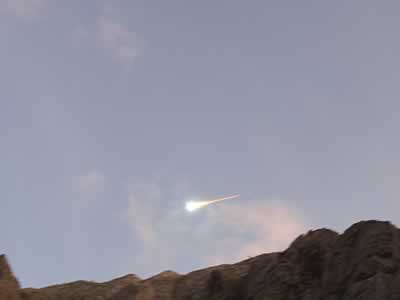
Impresive image obtained from the Leon mountains by Salvador Diez. For publication
his author must be mentioned and the Spanish Fireball and Meteorite
Recovery Network.
 NEW FEATURES ON THE TRAJECTORY.
NEW FEATURES ON THE TRAJECTORY.
The video footage obtained by accidental observers allow us to judge the luminosity of the bolide in the magnitude -15/-18 range,
although it is still too early to speculate on the photometric mass of the original meteoroid, as some sources have done (to readily).
It is necessary to emphasize that the dimension of the object cannot be determined directly since the height of tens of kilometres on
which it is observed is too great to see its real dimensions. As long as we do not have studied in detail the obtained images, we
think that it is dangerous to assign a clear origin to the object, although already we know that it CANNOT be associated to the
Quadrantid meteor shower, as some have been suggesting. We do already have a PROVISIONAL TRAJECTORY
that we will present in due time to facilitate the investigations. It is not wise to hurry in a work of such importance. We emphasize nevertheless
that the bolide did not follow a route crossing the Peninsula diagonally from the Northwest as some of the mass media have
reported, without any foundation in facts. The path was much shorter and restricted to the area between Zamora, Leon and Palencia, and it traveled in a different direction.
STEPS TO FOLLOW IF YOU WISH TO SEND INFORMATION ON THE CHARACTER Of THE BOLIDE.
Tens of people have already facilitated us with data on the trajectory along which they saw the bolide travel
at their place of residence, although this so far did not yet provide us with detailed enough information on the bolide trajectory. If you
did happen to have seen it, you too can contribute much to the ongoing investigation by contributing your data, and we will acknowledge
it, as you deserve it, in the final report on the investigation. At the moment we are gathering all possible information, we request your
participation to it too.
STEPS TO FOLLOW:
1. Reconstruction of the observation: in order for your data to have real value, and since the bolide was observed in broad daylight, it is fundamental that you return to the same place from where you observed it, and take a digital image showing to the horizon and all the buildings that can possibly serve as reference.
2. Identification of the cardinal points: determine the cardinal points (directions on a compass) of prominent points which appear in the photo. If you don't have a camera, make a scetch of the points that serve as a reference, marking the relevant reference directions clearly with regard to objects on the horizon. Use the heights and positions of objects on the photographs to draw a reconstruction on the photograph of the path of travel of the bolide, especially its point of start and its endpoint.
3. Geographical location: if it is possible for you to arrange to get a GPS receiver you can provide us with an as exact as possible geographic latitude, longitude and the altitude of the location from which you observed the fireball. If you don't have a GPS, please mark your location on a topographic map of good resolution and digitize the map. Send the digitized map to us together with your digitized photograph. Unfortunately this requires a bit more experience and it is not easy to everyone, but please try.
OPTIONS FOR EXPERIENCED OBSERVERS:
i. One other possibility is that, if you know someone which can lend you a theodolite and you know how to measure with it (or alternatively you can ask the owner to assist you with it), you could directly go to the same place from which you saw the fireball and determine with the best precision that is possible the azimuth and the height of the beginning points and end of the bolide.
ii. Finally if you have astronomical knowledge, try to to contribute the information to us which we request in
our bolide report . When you copy it and mail it, make sure that all the data are correctly filled in.
If you submitt your data and images to us by by electronic mail we may contact you within a few days to request more data if we feel that necessary.
Maybe we might solicit you to provide us a nighttime image taken from the same place, in order to exactly calibrate your results. This will require some time investment from you, reason why certainly your collaboration will be mentioned explicitly in the different scientific publications that we will produce, unless you solicit to remain anonymous. Send your pictures and data to this
e-mail address.
Up to a few years ago in Spain this impressive event could easily and sadly have been assigned an unexplained
UFO sighting. However, these phenomena can be BE IDENTIFIED better today, as parts of the public now has
digital cameras with which to film these impressive events. In addition, our Spanish Fireball and Meteorite
Recovery Network has started to use new techniques on image and data processing, and thanks to the
work of this group of young Spanish scientists, we can provide rational explanations for these phenomena basid
on solid and conclusive arguments. These bolides are luminous phenomena produced when a fragment of comet
or asteroid is disintegrating upon entrance into the terrestrial atmosphere or, on special occasions, it can be
produced by the re-entry of satellite debris. Whatever it is, our Network of Investigation on Bolides and Meteorites
is making sure that these things will not go unnoticed, and we will provide sound explanations of them to the public.
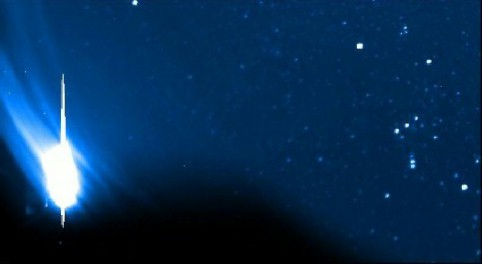
Image of another great bolide registered by our Network. It is the
27 of January 2003 fireball. .
For publication Dr Alberto Castro-Tirado must be mentioned and equipment BOOTES/INTA-CSIC in
collaboration with the Spanish Fireball and Meteorite
Recovery Network.
And OUR THANKS To ALL The SKY WATCHERS IN THIS PROJECT....
...which not only includes professionals but also many afficionados who provide information that contribute to our
work and data summaries. We want to thank the tens of people who have cooperated with us in this work. We are
especially grateful for the information sent on the appearance and trajectory of the bolide by: Vicente-Juan Ballester
Olmos, Javier Benedit, Saúl Blanco Lanza, Josep Cross, Jose Ignacio Cuende, Sergio Dalmau, Alvaro Faraco, Vicent Favà, Fernando Fontenla,
Francisco M. Garrido Guerrero, Montse Guiu, Jaime Izquierdo, Maria Maximina Robles,
Francisco Ocaña Gonzalez, Joan Penalver, José María Pérez, Alejandro Polanco, Ramon Puigmneró, Miquel Rafa,
Oscar To Rodriguez Baquero, Mari Carmen Nephews, Jesús San José, Joaquin Tapioles, Jordi Tapioles, J. Torra and Raul Varona
Ruiz and those who have preferred to stay in anonymity. We are also grateful to Jose Antonio Quesada, Pablo Santos del
of the "Instituto de Astrofisica de Andalucia (IAA, CSIC)" and to Salvador Díez who obtained from Las Hoces (Leon)
images of the bolide of extraordinary scientific value. Our thanks also go to the Leon Association
of Astronomy for cooperating with us in the calibration of images and especially to its
president and vice-president: Jesús San José and Ricardo Chao Prieto.
We also thank the apportation to the La Robla School in Leon, in special to: Omar Álvarez Gutiérrez, Diego Bobis Villagrá, José Mª Folledo Ferrero
and Jorge Borjas Fernández.
We are thankful for this altruistic work that is certainly valued well by us. If you still have something to contribute,
do not doubt in writing an
e-mail. Especially any images of the event are highly appreciated.
OTHER RESULTS OF OUR GROUP.
Here you can read a
summary of the work of our team concerning the bolide of 27 january 2003
If those who remember the
re-entry of the Chinese rocket Shenzou over Spain on 27 November 1999 want to read an article on artificial bolides,
you can read it at the end of the publication "Bólidos artificiales y chatarra espacial"
See the impresive movie obtained from León here.
The same movie from León
in animated gif format.
OTHER NOTES OF INTEREST:
You can also read about us on INFOASTRO
Excelent information in English on the "4 January fireball"
by Marco Langbroek (Dutch Meteor Society).
|













